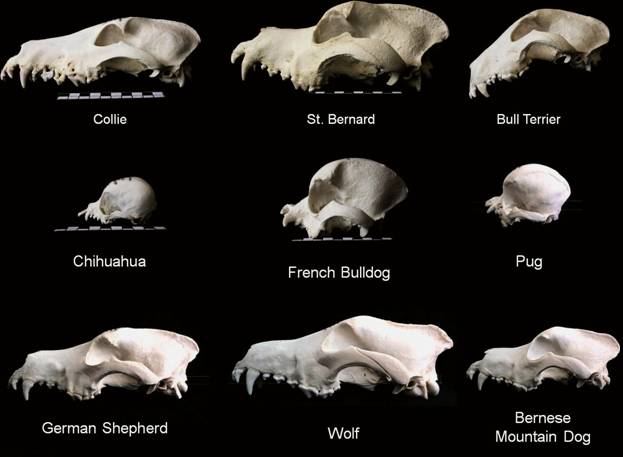I have always loved dogs and have had them since a young age and so thought this month I would focus on the domestic dog. Due to the large amount of selection that humans have placed on the domestic dog many varying breeds exist. Walking down the street you can see dogs which are small, large, short, broad, long or tall and as you would expect this degree of variation can also be seen in the canine skull. This page will start off discussing the canine skull in it’s general sense but will probably branch out to look and more specific breeds as the month goes on.
The Latin name for the domestic dog is Canis lupus familiaris and all are descended from the grey wolf Canis lupus. The dog has evolved over several thousands of years with some breeds evolving only over a few hundred years. This time scale is relatively brief for the amount of variation which is seen today when compared to natural selection and this is all down to human selection. The features that were deemed desirable were then accentuated over time, and a good example of this is dogs like the pug or bull dog where the snout has been selected to become shorter and flatter giving them their distinctive facial structure.
Due to this selection there are three different skull types for the domestic dog the dolichocephalic, mesocephalic and brachycephalic skull. The ancestor skull for all three types would have been the wolf and therefore have it’s basic shape which has then been pulled, pinched and/or compacted. The dolichocephalic skull belongs to dogs like the greyhound which have a long and narrow snout. It can be seen that these skulls are much thinner and more gracile than the wolf’s. The second type of skull is shorter and broader than the wolf and has larger nasal chambers which improve their ability to smell and therefore belong to dog breeds such as pointers or scent hounds. The final skull type, the brachycephalic, have much shorter snouts giving them a compact skull. This can be seen in the pug or bulldog and other fighting dogs which may give them a better biting force but compromises their ability to breathe and cool down. It is amazing that such a wide range of animals can all be descended from one common ancestor and still survive today, albeit with the help of humans.
Although the skull may vary in size and shape their teeth do not. When a puppy is born no teeth are present but by 60 days old the puppy teeth have grown through with the teeth usually erupting by the age of 6 months. The dental formula for a puppy is I: 3/3 C: 1/1 P: 3/3 M: 0/0 and for an adult I: 3/3 C1/1 P 4/4 M2/3. The dental formula works as following : I – incisors, C – canines, P- premolar, M – molar with a number stating how many of each tooth type is present. The ‘slash’ depicts which jaw the teeth are situated i.e upper jaw/lower jaw. For a full overview visit this website about canine evolution. The teeth are representative of an animal which is carnivore who has teeth for ripping and tearing. This is also assisted by the fact that the canine jaw does not move side-to-side like a herbivore and doesn’t allow for chewing. This is why dogs are seen to gulp their food quickly as it would have been a survival strategy in the wild.
I think that the dog is an amazing animal and a great companion and I look forward to looking more deeply into their evolution and anatomy. To read about the geographic origins of the domestic dog view my page looking at a paper by Thalmann et al. (2013) which uses genomes to investigate this and then a quick look at the archaeological evidence!
Since writing this I’ve also had written a couple of posts involving the domestic dog. These include how they were viewed in Ancient Egypt and how a cancer in the domestic dog dates back to 11,000 years, making it the oldest surviving cancer. In addition to this a recent study (Freeman et al. 2014) has revealed that there was a bottleneck in wolf populations around 15,000 years ago around the same time as dogs diverged from wolves. To check out the article go to my post for a quick overview of the paper.
References/Interesting Links:
Article: Large-Scale Diversification of Skull Shape in Domestic Dogs: Disparity and Modularity
Dental Formula for Humans and Different Domesticated Species
YouTube clip: George the Pug from Pedigree Dogs Exposed



Pingback: World’s Oldest-known Living Cancer Dates back 11,000 years | Beauty in the Bones
Pingback: June’s Skull of the Month – the Domestic Cat | Beauty in the Bones
Pingback: A Look into Cat Genomics | Beauty in the Bones
Pingback: 9 Touching Epitaphs Ancient Greeks And Romans Wrote For Their Deceased Dogs | Beauty in the Bones
Great post and super helpful links, thanks for posting!
LikeLike
Thanks Nick! Glad it was of help 🙂
LikeLike